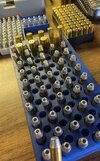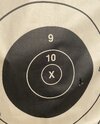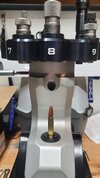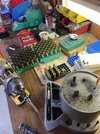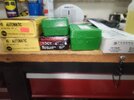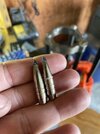You are using an out of date browser. It may not display this or other websites correctly.
You should upgrade or use an alternative browser.
You should upgrade or use an alternative browser.
What did you do in the reloading room today?
- Thread starter Mike Overlay
- Start date
- Replies 5,512
- Views 243,332
17tombstone
Well-Known Member
Would be interested in what the load is. Great shooting
Great range day today! It was too pretty not to get out there. The target shown confirms my hypothesis that the match primers and bullet seating technique I use for my high-precision loads *do* make a difference. Seating technique does matter more than primer choice, but both together especially matter. The top-left and center loads are the best, and were expected to be the best. They'd both be half-inch groups without flyers that were absolutely my fault. Ten shots each, 100yds, 77gr SMKs loaded as Mk262 copies. 18" Daniel Defense S2W 5.56 barrel, AR15. Best two groups are still 1moa even with the flyers. Center group (loaded with Lake City brass, the primary brass I use for these loads) had a standard deviation of 8fps. 10fps SD for the top left group (loaded with PMC XTAC brass. I wanted to see how PMC would compare). So the extra effort and materials choice does make the difference, and that is important to know going forward. Tagging @AR-180 as he expressed interest in hearing how this went. 
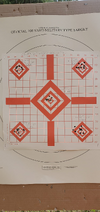

backwoodsshooter
there’s always a method to the madness
decided to buy the inline fab quick change mount. Got the Loadmaster, APP and the Square B finally in to the reloading room and setup up on their plates. Wish I would have bough this stuff sooner.
I'll try to get pics once I get everything cleaned up and better organized
I'll try to get pics once I get everything cleaned up and better organized
Snoopz
Well-Known Member
Yeah man..great system.. have the flush mount system, works great. Inline Fab generally has sales at least 2x a year, thats when I buy.decided to buy the inline fab quick change mount. Got the Loadmaster, APP and the Square B finally in to the reloading room and setup up on their plates. Wish I would have bough this stuff sooner.
I'll try to get pics once I get everything cleaned up and better organized
-Snoopz
Decided to redesign my reloading space to hopefully make it less messy. I had a top of a desk on top of my reloading bench that I was using (first pic) but have upgraded with 3 small book cases, a peg board and 3 not yet installed kitchen cabinets. Hopefully it will not only give me more space but will be more organized.
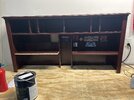
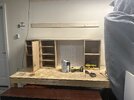




Glad to see someone shooting more than a 3 round "group". What's your seating technique and how does it make a difference?Great range day today! It was too pretty not to get out there. The target shown confirms my hypothesis that the match primers and bullet seating technique I use for my high-precision loads *do* make a difference. Seating technique does matter more than primer choice, but both together especially matter. The top-left and center loads are the best, and were expected to be the best. They'd both be half-inch groups without flyers that were absolutely my fault. Ten shots each, 100yds, 77gr SMKs loaded as Mk262 copies. 18" Daniel Defense S2W 5.56 barrel, AR15. Best two groups are still 1moa even with the flyers. Center group (loaded with Lake City brass, the primary brass I use for these loads) had a standard deviation of 8fps. 10fps SD for the top left group (loaded with PMC XTAC brass. I wanted to see how PMC would compare). So the extra effort and materials choice does make the difference, and that is important to know going forward. Tagging @AR-180 as he expressed interest in hearing how this went.
View attachment 757277
Definitely.Glad to see someone shooting more than a 3 round "group". What's your seating technique and how does it make a difference?
My seating technique is as follows:
-Use Hornady seating die with a Hornady MicroJust seating stem (though I do want to try Forsters at some point, this is just what I have)
-Purposefully set MicroJust seating stem to seat 10-20 thousandths of an inch too long, with no crimp from the seating die
-Measure existing COAL with Micrometer
-Compute difference between existing COAL and prescribed COAL
-Adjust MicroJust seating stem the amount necessary to seat to exact prescribed COAL
-Measure existing COAL with Micrometer
-If within one-thousandth of an inch of prescribed COAL, sit in box and move on to next cartridge
-If greater than one-thousandth of an inch too long, adjust MicroJust seating stem again by half the difference needed to make prescribed COAL (since it seems to be more finicky at this point)
-Rinse and repeat until within one-thousandth of an inch of prescribed COAL
-Crimp on a separate crimping die if the load calls for it (currently for me this is everything but my 308win loads for my precision bolt action rifle, since I shoot a lot of ARs and lever action rifles))
Doing this for every cartridge tends to shrink group sizes by about half to a quarter what they would be otherwise (as shown by the target in my above post).
Last edited:
Oh OK, gotcha. Yeah I don't get too far in the weeds with seating. Once I get it set, I will go to running them and check every so often. Most of mine are normally within a thou or so. I do pay a lot of attention to seating depth in relation to how far in the case it sits though.
I don't crimp my 6ARC,300 BLK or 6GT. The ARC and 300 is a GG and the GT is a bolt. I do set neck tension with a mandrel though and do not use an expander in my sizing die. Has been working great for me and with properly annealing the cases the neck tension is pretty consistent. 223 I think would benefit from a light crimp as I am not going to go through the trouble of running them over a mandrel.
I don't crimp my 6ARC,300 BLK or 6GT. The ARC and 300 is a GG and the GT is a bolt. I do set neck tension with a mandrel though and do not use an expander in my sizing die. Has been working great for me and with properly annealing the cases the neck tension is pretty consistent. 223 I think would benefit from a light crimp as I am not going to go through the trouble of running them over a mandrel.
Oh wow. If your stuff is already within one-thousandth without worrying about specifically seating to a certain length, that means I'm missing a critical step that you're doing, but I'm not. Without doing the process I described, the COAL varies around 5-10 thousandths from average COAL on each round with most bullets, which tends to produce groups on paper and that are woefully underwhelming compared to the loads I take the extra time on. I tried chasing the optimal distance to the lands, but since all my guns are magazine fed I've gone back to just loading to the COAL that the reloading manual tells me to set the cartridges to. If ever I get something bigger and fancier than a 308win, or do a custom gun though, I will have the distance to the lands measured so I can try doing COAL based on that. For now, all my crimp cartridges are seating where the cannelure sits correctly, so I'm good there at least.Oh OK, gotcha. Yeah I don't get too far in the weeds with seating. Once I get it set, I will go to running them and check every so often. Most of mine are normally within a thou or so. I do pay a lot of attention to seating depth in relation to how far in the case it sits though.
I don't crimp my 6ARC,300 BLK or 6GT. The ARC and 300 is a GG and the GT is a bolt. I do set neck tension with a mandrel though and do not use an expander in my sizing die. Has been working great for me and with properly annealing the cases the neck tension is pretty consistent. 223 I think would benefit from a light crimp as I am not going to go through the trouble of running them over a mandrel.
Fair enough. I don't crimp for my 308 since it's a precision bolt action and the mags kind of get babied, so the increased performance consistency is more important than durability to me. For my ARs and tube-fed lever guns though, I do crimp because getting rattled or compressed in their magazine could be a major issue if I didn't.
Setting neck tension is something I have never done, and that I wonder is the missing link that I need to experiment with in my loading process. That is something I could definitely use advice on. That to me makes the most sense for why my seating seems to be less consistent than you're saying yours is. After watching some Youtube videos on the subject, it sounds like getting some sort of expander die/mandrel kit is what I'd need to start setting my neck tension. I've seen anywhere from one to three thousandths under base caliber being considered optimal, so I'll just have to get one of each mandrel and see which one gives the best metric and grouping performance. Do you have any recommendations on what die and mandrel set to get?
I unfortunately am not in a situation where I can really anneal my cases, due to limitations with my reloading room setup. I do very much want to get into annealing cases, I just don't have a way to do so now. I wish I did though, because it does apparently improve longevity and consistency of the cases.
Last edited:
How are you measuring? Are you doing COAL or base to Ogive? How is your ES and SD over a 10-20 round group?Oh wow. If your stuff is already within one-thousandth without worrying about specifically seating to a certain length, that means I'm missing a critical step that you're doing, but I'm not. Without doing the process I described, the COAL varies around 5-10 thousandths from average COAL on each round with most bullets, which tends to produce groups on paper and that are woefully underwhelming compared to the loads I take the extra time on. I tried chasing the optimal distance to the lands, but since all my guns are magazine fed I've gone back to just loading to the COAL that the reloading manual tells me to set the cartridges to. If ever I get something bigger and fancier than a 308win, or do a custom gun though, I will have the distance to the lands measured so I can try doing COAL based on that. For now, all my crimp cartridges are seating where the cannelure sits correctly, so I'm good there at least.
Fair enough. I don't crimp for my 308 since it's a precision bolt action and the mags kind of get babied, so the increased performance consistency is more important than durability to me. For my ARs and tube-fed lever guns though, I do crimp because getting rattled or compressed in their magazine could be a major issue if I didn't.
Setting neck tension is something I have never done, and that I wonder is the missing link that I need to experiment with in my loading process. That is something I could definitely use advice on. That to me makes the most sense for why my seating seems to be less consistent than you're saying yours is. After watching some Youtube videos on the subject, it sounds like getting some sort of expander die/mandrel kit is what I'd need to start setting my neck tension. I've seen anywhere from one to three thousandths under base caliber being considered optimal, so I'll just have to get one of each mandrel and see which one gives the best metric and grouping performance. Do you have any recommendations on what die and mandrel set to get?
I unfortunately am not in a situation where I can really anneal my cases, due to limitations with my reloading room setup. I do very much want to get into annealing cases, I just don't have a way to do so now. I wish I did though, because it does apparently improve longevity and consistency of the cases.
Precision rounds are something that you could spend a ton of time on. You have to decide what level of precision AND accuracy you want to achieve. Case volume, primer weight, neck tension, powder fill percentage, powder burn rate, bullet seating, neck concentricity, annealing and on and on . I do the things I feel will get the best return on my time reloading. I do feel setting neck tension with a mandrel is far better than pulling an expander back through what you have just sized. As far as the mandrels go, I use https://21stcenturyinnovation.com/buy-online and have been happy with them.
Annealing not only helps with the case hardening of the brass but helps keep it a little more consistent.
What kind of precision are you getting with your process? Are you shooting benchrest or f-class?How are you measuring? Are you doing COAL or base to Ogive? How is your ES and SD over a 10-20 round group?
Precision rounds are something that you could spend a ton of time on. You have to decide what level of precision AND accuracy you want to achieve. Case volume, primer weight, neck tension, powder fill percentage, powder burn rate, bullet seating, neck concentricity, annealing and on and on . I do the things I feel will get the best return on my time reloading. I do feel setting neck tension with a mandrel is far better than pulling an expander back through what you have just sized. As far as the mandrels go, I use https://21stcenturyinnovation.com/buy-online and have been happy with them.
Annealing not only helps with the case hardening of the brass but helps keep it a little more consistent.
I have thought that some mid-range F Class might be fun but have never tried it. I shoot long range mostly and have shot a few PRS style matches. That's a game that takes some figuring out. Sounded easy at the time,What kind of precision are you getting with your process? Are you shooting benchrest or f-class?
I tried the case weight and volume, measuring projectiles etc, and just didn’t see any difference at range. That’s why I was wondering if you were shooting f or bench. They won’t let you shoot f with a suppressor even for fun, paying, ask me how I know, lol.I have thought that some mid-range F Class might be fun but have never tried it. I shoot long range mostly and have shot a few PRS style matches. That's a game that takes some figuring out. Sounded easy at the time,.
Oh no, I don't do any of that either. I was just saying you could get deep in the weeds with obsessing over reloading. I deprime, dry tumble, anneal, size, mandrel, 3 way trim, dry tumble, prime, charge, seat and shoot.I tried the case weight and volume, measuring projectiles etc, and just didn’t see any difference at range. That’s why I was wondering if you were shooting f or bench. They won’t let you shoot f with a suppressor even for fun, paying, ask me how I know, lol.
My first efforts in loading rifle rounds for accuracy was with 223 loads for my PSA 20" AR. I started with 223 since it was fairly inexpensive to do a lot of shooting and experimenting. However, I tried lots of different things, trying to see what made differences. When I first got started, I found out quickly the limiting factor was (and still is, to a large extent) ME.
I did several A vs B experiments along the way. I tried different brass. I deburred the flash holes (made no difference). I compared annealed to non-annealed (very little difference, but I do believe it will help with brass longevity).
I compared no-crimp, light crimp, heavy crimp. BIG difference, with no-crimp being the most accurate. I believe that the lighter the neck tension, the more accurate (at least that has been my observation - YMMV). It may just be that the lighter crimp has more consistency than the heavier crimps. I manually cycled the rounds through my gun to make sure I wasn't getting setback or jump - There was none with 75gn bullets, so my standard load for my AR is with no crimp.
I, too, have settled on using a mandrel expander from 21st Century. I will use those for any precision rifle I load for. I also use a Wilson chamber style seating die, as that has shown to have less runout than anything I tried so far (Forster is very close). With the Wilson seating die, I use an arbor press with a force gauge on it, that gives me a way to measure the neck tension. Any outliers I will set aside to use for fouling shots. I turn the necks to make consistent neck thickness. (That made a measurable difference in SD and ES). I use a Redding type S bushing style sizing die, and picked a bushing that gives me just slightly smaller than the mandrel expander. I work the brass a lot less doing that, and get a consistent inside diameter.
With all of that experimenting, I have gotten a few < 0.5 moa groups, but I usually get 0.75 moa from a relatively cheap gun with fairly inexpensive bullets. I'm very happy with that, and feel like I have learned a lot.
I'm still in the early stages of working up loads for a factory stock 6.5C Bergara, but I feel like I have learned enough to help me in my endeavor. I'm probably never going to be a 0.25 moa shooter, but anything around a consistent 0.5 moa will make me very happy.
I will admit that some of the things I tried early on that didn't seem to make a difference may have been lost "in the noise floor", in other words, they may make a small difference that can't be seen until I get down to tiny groups. It can be an endless rabbit hole.
I did several A vs B experiments along the way. I tried different brass. I deburred the flash holes (made no difference). I compared annealed to non-annealed (very little difference, but I do believe it will help with brass longevity).
I compared no-crimp, light crimp, heavy crimp. BIG difference, with no-crimp being the most accurate. I believe that the lighter the neck tension, the more accurate (at least that has been my observation - YMMV). It may just be that the lighter crimp has more consistency than the heavier crimps. I manually cycled the rounds through my gun to make sure I wasn't getting setback or jump - There was none with 75gn bullets, so my standard load for my AR is with no crimp.
I, too, have settled on using a mandrel expander from 21st Century. I will use those for any precision rifle I load for. I also use a Wilson chamber style seating die, as that has shown to have less runout than anything I tried so far (Forster is very close). With the Wilson seating die, I use an arbor press with a force gauge on it, that gives me a way to measure the neck tension. Any outliers I will set aside to use for fouling shots. I turn the necks to make consistent neck thickness. (That made a measurable difference in SD and ES). I use a Redding type S bushing style sizing die, and picked a bushing that gives me just slightly smaller than the mandrel expander. I work the brass a lot less doing that, and get a consistent inside diameter.
With all of that experimenting, I have gotten a few < 0.5 moa groups, but I usually get 0.75 moa from a relatively cheap gun with fairly inexpensive bullets. I'm very happy with that, and feel like I have learned a lot.
I'm still in the early stages of working up loads for a factory stock 6.5C Bergara, but I feel like I have learned enough to help me in my endeavor. I'm probably never going to be a 0.25 moa shooter, but anything around a consistent 0.5 moa will make me very happy.
I will admit that some of the things I tried early on that didn't seem to make a difference may have been lost "in the noise floor", in other words, they may make a small difference that can't be seen until I get down to tiny groups. It can be an endless rabbit hole.
With that creed, if you want to shoot little, Lapua brass, br2 primers, h4350, Berger 140 hybrid, Redding type s bushing fl sizer with comp seater is all you need, and a trigger tech diamond at 16oz, you’ll be golden. Don’t bump the shoulder on the first 2 firings, you’ll know when you need to bump the shoulder the first time.My first efforts in loading rifle rounds for accuracy was with 223 loads for my PSA 20" AR. I started with 223 since it was fairly inexpensive to do a lot of shooting and experimenting. However, I tried lots of different things, trying to see what made differences. When I first got started, I found out quickly the limiting factor was (and still is, to a large extent) ME.
I did several A vs B experiments along the way. I tried different brass. I deburred the flash holes (made no difference). I compared annealed to non-annealed (very little difference, but I do believe it will help with brass longevity).
I compared no-crimp, light crimp, heavy crimp. BIG difference, with no-crimp being the most accurate. I believe that the lighter the neck tension, the more accurate (at least that has been my observation - YMMV). It may just be that the lighter crimp has more consistency than the heavier crimps. I manually cycled the rounds through my gun to make sure I wasn't getting setback or jump - There was none with 75gn bullets, so my standard load for my AR is with no crimp.
I, too, have settled on using a mandrel expander from 21st Century. I will use those for any precision rifle I load for. I also use a Wilson chamber style seating die, as that has shown to have less runout than anything I tried so far (Forster is very close). With the Wilson seating die, I use an arbor press with a force gauge on it, that gives me a way to measure the neck tension. Any outliers I will set aside to use for fouling shots. I turn the necks to make consistent neck thickness. (That made a measurable difference in SD and ES). I use a Redding type S bushing style sizing die, and picked a bushing that gives me just slightly smaller than the mandrel expander. I work the brass a lot less doing that, and get a consistent inside diameter.
With all of that experimenting, I have gotten a few < 0.5 moa groups, but I usually get 0.75 moa from a relatively cheap gun with fairly inexpensive bullets. I'm very happy with that, and feel like I have learned a lot.
I'm still in the early stages of working up loads for a factory stock 6.5C Bergara, but I feel like I have learned enough to help me in my endeavor. I'm probably never going to be a 0.25 moa shooter, but anything around a consistent 0.5 moa will make me very happy.
I will admit that some of the things I tried early on that didn't seem to make a difference may have been lost "in the noise floor", in other words, they may make a small difference that can't be seen until I get down to tiny groups. It can be an endless rabbit hole.
Loaded up a bunch of .17 Remington Fireball today. First round of the Hornady V-Max 25 grain bullet came out of the Redding Competition Seater die, missing its polymer tip and pulling the bullet out of the case a few thousandths, just because the seater die appeared to capture the polymer tip quite firmly.
I super-glued the tip back into the bullet, stuck a wad of paper towel in the die, and had no more trouble.
I’ll contact Redding and see if they have seen this before. I don’t normally use polymer tipped bullets, except on .30 caliber rounds, but these are all I could find.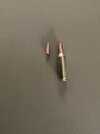 With the .17, dimensions are so small, any slight deviation in tolerances can cause problems.
With the .17, dimensions are so small, any slight deviation in tolerances can cause problems.
I super-glued the tip back into the bullet, stuck a wad of paper towel in the die, and had no more trouble.
I’ll contact Redding and see if they have seen this before. I don’t normally use polymer tipped bullets, except on .30 caliber rounds, but these are all I could find.
 With the .17, dimensions are so small, any slight deviation in tolerances can cause problems.
With the .17, dimensions are so small, any slight deviation in tolerances can cause problems.I was loading some 6GT and remembered to grab some pics. Here is 3 that were done right in a row. I will normally check about every 10 or so. Target for these is 1.945Oh wow. If your stuff is already within one-thousandth without worrying about specifically seating to a certain length, that means I'm missing a critical step that you're doing, but I'm not. Without doing the process I described, the COAL varies around 5-10 thousandths from average COAL on each round with most bullets, which tends to produce groups on paper and that are woefully underwhelming compared to the loads I take the extra time on. I tried chasing the optimal distance to the lands, but since all my guns are magazine fed I've gone back to just loading to the COAL that the reloading manual tells me to set the cartridges to. If ever I get something bigger and fancier than a 308win, or do a custom gun though, I will have the distance to the lands measured so I can try doing COAL based on that. For now, all my crimp cartridges are seating where the cannelure sits correctly, so I'm good there at least.
Fair enough. I don't crimp for my 308 since it's a precision bolt action and the mags kind of get babied, so the increased performance consistency is more important than durability to me. For my ARs and tube-fed lever guns though, I do crimp because getting rattled or compressed in their magazine could be a major issue if I didn't.
Setting neck tension is something I have never done, and that I wonder is the missing link that I need to experiment with in my loading process. That is something I could definitely use advice on. That to me makes the most sense for why my seating seems to be less consistent than you're saying yours is. After watching some Youtube videos on the subject, it sounds like getting some sort of expander die/mandrel kit is what I'd need to start setting my neck tension. I've seen anywhere from one to three thousandths under base caliber being considered optimal, so I'll just have to get one of each mandrel and see which one gives the best metric and grouping performance. Do you have any recommendations on what die and mandrel set to get?
I unfortunately am not in a situation where I can really anneal my cases, due to limitations with my reloading room setup. I do very much want to get into annealing cases, I just don't have a way to do so now. I wish I did though, because it does apparently improve longevity and consistency of the cases.


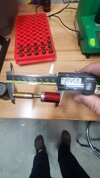
Snoopz
Well-Known Member
Looking good there boss. Slide everything to the side, have at it, the old standby Dewalt drill?Sort, Clean, deprime, size, trim, deburr, chamfer, then tumble and reinspect some 45-70 brass for upcoming matches. I’m new to it so have to do it all the first time. Halfway through.
View attachment 761724
45/70 been thinking about one, just like the biggies, beats them lil 25gr 17 cal bullets ( rice grains ) and them small cases 22 hornet..
-Snoopz
Yessir. I like that drill trimmer. The part that holds the cases is too small out of the box so I weld extra bit on it to have something to hold into but otherwise it’s good stuff. Come to the farm and you can shoot one of my 45-70’s . They’re addictive!Looking good there boss. Slide everything to the side, have at it, the old standby Dewalt drill?
45/70 been thinking about one, just like the biggies, beats them lil 25gr 17 cal bullets ( rice grains ) and them small cases 22 hornet..
-Snoopz
Last edited:
Ohhhh that press. So is it worth the hype and price ? I was following them as they were designing that press.Trying to finish up the 300BLK that's been on the back burner for a while.
View attachment 755601
Well....It's a pleasure to use but I can also do some fine work on my Mec Marksman. That Mec flies under the radar in my opinion anyways especially for the price. The Zero a nice press and solid. Nothing moves on it but the ram. There is zero slop in anything. It's based on the idea of having the shell holder contact the die for the stop. This is the reason for having to use the Redding Comp shell holders. So far they have worked out well and I can't complain about the performance. Just have to keep up with what shell holder you need for whatever case you're working on.Ohhhh that press. So is it worth the hype and price ? I was following them as they were designing that press.
Yep, I picked up 200 Lapua cases to get started with. First attempts were with Hornady bullets, but I seem to remember I ordered some Berger bullets as well - I will have to check. Federal match primers, and H4350.With that creed, if you want to shoot little, Lapua brass, br2 primers, h4350, Berger 140 hybrid, Redding type s bushing fl sizer with comp seater is all you need, and a trigger tech diamond at 16oz, you’ll be golden. Don’t bump the shoulder on the first 2 firings, you’ll know when you need to bump the shoulder the first time.
I also use the Redding competition shell holders. I go for about 0.002” headspace when I size.
What's up with that one on the right?I love the sound of Varget “crunching” in the morning! Slightly compressed load. Velocities not impressive BUT that’s out of a SOCOM 16” so I’ll take it. Loading some free Nickel Trophy Bonded LE projectiles I won in a raffle on REDEYE RELOADING a couple of years ago.
View attachment 763287
View attachment 763281
Been sizing and otherwise prepping a few hundred FC .308 brass... nothing impressive about the brass but they're consistent, cycle well, and I have >1200 of them. Craziest thing is I've had to trim every piece and its once-fired!
I have more prepped than I am going to shoot for the next several months. At this point I'm procrastinating because I can't figure out how to get anything resembling consistent powder throws with Varget so it's going to be a looooooooooong night of scooping and trickling.
I have more prepped than I am going to shoot for the next several months. At this point I'm procrastinating because I can't figure out how to get anything resembling consistent powder throws with Varget so it's going to be a looooooooooong night of scooping and trickling.
Pretty crazy to see! Thanks for the follow-up!I know right. They’re all 168gr .308 but some have the canneleure in one spot and some in others and some none at all. They all weigh the same tho.. They were Federal pulls a guy raffled off.View attachment 763338
Oh my OCD is in full force!!Pretty crazy to see! Thanks for the follow-up!


